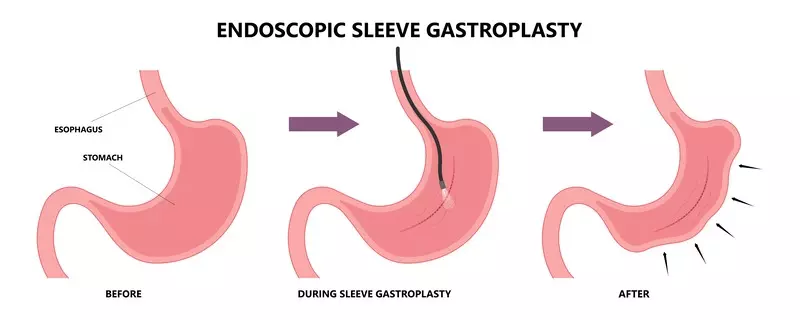The endoscopic sleeve procedure represents a significant advancement in bariatric medicine, offering patients a minimally invasive alternative to traditional weight loss surgeries. Unlike conventional surgical approaches that require multiple incisions and extensive tissue manipulation, this procedure utilizes flexible endoscopic technology inserted through the mouth to reduce stomach volume without external cuts. Clinical studies demonstrate impressive outcomes with patients experiencing 15-20% total body weight loss within the first year post-procedure, while enjoying substantially reduced recovery times compared to traditional bariatric surgeries.
The procedure’s rising popularity stems from its compelling combination of effectiveness and safety. The endoscopic approach dramatically reduces complications such as infection, bleeding, and prolonged hospital stays that often accompany conventional surgical interventions. Furthermore, the endoscopic sleeve serves as a viable option for patients with BMI ranges of 30-40 who may not qualify for more invasive procedures but require medical intervention beyond lifestyle modifications alone. The reduced physical trauma allows patients to return to normal activities within days rather than weeks, representing a paradigm shift in obesity treatment that balances meaningful weight loss results with decreased procedural risks and patient burden.
ESG Procedure Process and Medical Terms
The endoscopic sleeve gastroplasty (ESG) procedure involves precise steps performed entirely through the mouth without surgical incisions. This non-surgical procedure utilizes advanced endoscopic technology to reduce stomach capacity.
Endoscopic sleeve gastroplasty works through the following structured process:
- Anesthesia administration for patient comfort
- Insertion of the endoscope through the mouth into the stomach
- Visualization of the stomach’s interior using the endoscope camera
- Strategic placement of sutures using the OverStitch endoscopic suturing system
- Suturing the stomach from bottom to top in a specific pattern
- Creation of a sleeve-shaped restriction along the greater curvature
The endoscopic gastric sleeve procedure employs several specialized medical components:
- Endoscope: Flexible tube with camera and light source
- OverStitch device: Specialized suturing system designed for endoscopic procedures
- Tissue helix: Instrument that grasps stomach tissue for suturing
- Suture cinch: Device that secures and tightens suture placement
The accordion pattern technique is a key element in how endoscopic sleeve works. This approach involves creating multiple tissue folds resembling an accordion, effectively reducing stomach volume by approximately 70%. The endoscopic sleeve gastrectomy (ESG) procedure typically takes 60-90 minutes to complete, with patients under general anesthesia throughout the process. The Gastric Sleeve Benefits Considerations are integral to understanding the potential outcomes of the endoscopic sleeve procedure. Post-procedure, patients can expect a shorter recovery time and a reduced risk of nutritional deficiencies compared to more invasive surgeries.
Benefits and Weight Loss Results
Endoscopic sleeve gastroplasty delivers significant weight loss results with numerous health benefits. Clinical studies show that patients typically experience substantial improvements in their overall wellbeing following this non-surgical procedure.
Key Benefits of Endoscopic Sleeve Gastroplasty:
- Substantial Weight Reduction: Endoscopic sleeve gastroplasty weight loss averages between 15-20% of total body weight within the first year
- Improved Metabolic Health: Most patients see measurable improvements in obesity-related conditions like type 2 diabetes and hypertension
- Enhanced Quality of Life: Patients report increased mobility, reduced joint pain, and improved sleep quality
- Long-term Success: Studies indicate that approximately 60-70% of excess weight loss can be maintained when paired with lifestyle changes
- Non-surgical Advantage: Achieves meaningful results without permanent anatomical alterations
| Timeframe | Average Weight Loss | Health Improvements |
|---|---|---|
| 3 Months | 10-15% excess weight | Reduced blood pressure, improved glucose levels |
| 6 Months | 15-18% excess weight | Decreased medication requirements |
| 12 Months | 15-20% excess weight | Significant reduction in metabolic syndrome markers |
| 24 Months | Maintained 60-70% of initial loss | Sustained health benefits with proper habits |
The before and after endoscopic sleeve gastroplasty results demonstrate the procedure’s effectiveness. The most dramatic transformations typically occur in the first six months as the reduced stomach capacity leads to decreased food intake. Patients with a BMI between 30-40 generally achieve the most optimal outcomes from the ESG procedure.
Endoscopic sleeve before and after comparisons reveal that beyond physical changes, patients experience psychological benefits including improved self-confidence and reduced depression symptoms. This comprehensive improvement in health metrics makes the endoscopic sleeve procedure benefits extend well beyond mere weight reduction.
Cost and Pricing of Endoscopic Sleeve Procedures
The endoscopic sleeve gastroplasty cost varies significantly across different regions and healthcare providers. Financial considerations are crucial when planning for this minimally invasive weight loss intervention.
| Region | Average Endoscopic Sleeve Procedure Cost | Price Range | Insurance Coverage |
|---|---|---|---|
| United States | $10,000 – $15,000 | $7,500 – $18,000 | Partial/Varies |
| United Kingdom | £8,000 – £12,000 | £7,000 – £14,000 | Private Only |
| Europe | €6,000 – €9,000 | €5,000 – €12,000 | Varies by Country |
| Australia | AUD 12,000 – 16,000 | AUD 10,000 – 18,000 | Limited |
The table above highlights the significant price variations for endoscopic sleeve surgery costs globally. The endoscopic weight loss surgery cost typically includes pre-operative consultations, the procedure itself, and limited follow-up care.
Most facilities offer various payment options for endoscopic sleeve procedures:
- Medical financing plans with extended payment terms and reasonable interest rates
- Healthcare credit cards specifically designed for medical procedures
- Flexible spending accounts (FSAs) or health savings accounts (HSAs)
- Cash discounts typically ranging from 5-15% for full upfront payment
The endoscopic sleeve gastroplasty price in UK medical centers often includes comprehensive aftercare packages. Patients should verify all included services when comparing quotes, as some providers may charge additional fees for follow-up consultations or nutritional support that significantly impact the total endoscopic sleeve price.
Risks and Complications of ESG
Endoscopic sleeve gastroplasty (ESG) presents several potential complications that patients should be aware of before undergoing the procedure. While generally considered safer than surgical alternatives, understanding endoscopic sleeve procedure risks remains essential for informed decision-making.
Short-term complications of endoscopic sleeve gastroplasty include:
- Pain and nausea affecting approximately 33% of patients during the first 2-3 days
- Abdominal discomfort and cramping that may persist for up to two weeks
- Bleeding at suture sites, though significant hemorrhage occurs in less than 1% of cases
- Gastric perforation (stomach puncture) occurring in approximately 0.5% of procedures
- Infection at the intervention site requiring antibiotic treatment
The endoscopic sleeve procedure side effects that commonly occur during the first month include:
- Difficulty eating and feeling full quickly due to reduced stomach capacity
- Transient acid reflux symptoms that typically resolve within 4-6 weeks
- Nausea and vomiting if dietary recommendations are not followed carefully
- Dehydration resulting from inadequate fluid intake during the adaptation period
What are the risks of endoscopic sleeve gastroplasty in the long term? Research indicates several potential issues:
- Suture loosening occurring in approximately 15-20% of patients within the first year
- Weight regain if the stomach pouch gradually stretches over time
- Nutritional deficiencies particularly vitamins B12, D, and iron if supplements aren’t taken
- Persistent GERD symptoms in patients with pre-existing reflux conditions
Endoscopic sleeve gastroplasty long-term side effects may also include psychological impacts related to changing relationships with food and body image adjustments. Studies tracking patients beyond five years suggest that ongoing medical supervision is necessary to monitor and address complications that may develop over time.
ESG vs Other Weight Loss Procedures
Comparing endoscopic sleeve gastroplasty (ESG) with traditional bariatric procedures reveals significant differences in approach and invasiveness. The following table outlines how the non-surgical gastric sleeve option compares to other common weight loss interventions:
| Procedure Type | Invasiveness Level | Incisions | Anesthesia | Hospital Stay |
|---|---|---|---|---|
| Endoscopic Sleeve Gastroplasty | Minimally invasive | None | Moderate sedation | Outpatient |
| Gastric Bypass | Highly invasive | 5-6 small incisions | General | 2-3 days |
| Traditional Gastric Sleeve | Invasive | 5-6 small incisions | General | 1-2 days |
| Adjustable Gastric Band | Moderately invasive | 1-5 small incisions | General | 0-1 day |
This comparison highlights that endoscopic gastric reduction stands apart from traditional surgical approaches by eliminating the need for external incisions.
Key procedural differences between ESG and other weight loss approaches include:
- Endoscopic sleeve gastroplasty vs gastric bypass involves fundamentally different approaches to stomach modification. ESG uses endoscopic suturing while bypass requires surgical rerouting of the digestive tract.
- Access method differs significantly, with ESG performed entirely through the mouth using an endoscope rather than through abdominal incisions.
- Anatomical changes vary considerably between procedures. The non-surgical gastric sleeve preserves normal digestive anatomy while changing stomach capacity.
- Procedural reversibility represents another key distinction, with minimally invasive weight loss surgery generally offering greater potential for reversal than permanent surgical alternatives.
The endoscopic approach represents a middle ground in the spectrum of weight loss interventions. When comparing endoscopic sleeve procedure vs gastric bypass, medical professionals note the former preserves normal digestive function while still creating meaningful stomach restriction. This preservation of natural anatomy distinguishes ESG from more invasive bariatric surgeries that permanently alter digestive pathways.
Advanced endoscopic techniques have enabled these less invasive options that fit between lifestyle modifications and traditional surgery. For appropriate candidates, these minimally invasive weight loss surgery options expand the treatment spectrum available to address obesity effectively.
Recovery and Post-Procedure Experience
Endoscopic Sleeve Gastroplasty Recovery Timeline
- First 24-48 hours: Most patients experience moderate discomfort and nausea following endoscopic sleeve gastroplasty. During this period, clear liquids are the only permitted intake.
- Days 3-7: Transition to full liquids occurs as the initial recovery progresses. Patients typically report that endoscopic sleeve procedure recovery time begins to show significant improvement after the first week.
- Weeks 2-4: Soft foods are gradually introduced. Most patients can return to normal activities, though exercise restrictions remain in place.
- Weeks 4-6: Complete recovery usually occurs, with normal diet resumption under nutritionist guidance.
How painful is endoscopic sleeve gastroplasty? Most patients describe the discomfort as moderate and manageable with prescribed medications. The procedure causes significantly less pain than traditional surgical alternatives due to its non-invasive nature.
Pain Management Tips:
- Take prescribed medications according to the exact schedule
- Apply heating pads to the abdominal area for comfort
- Stay hydrated with approved clear liquids
- Maintain proper posture when resting
- Avoid sudden movements during the first week
Many patients wonder how long does endoscopic gastric sleeve last. Clinical studies demonstrate effectiveness for 2-5 years, with maintenance dependent on lifestyle adherence. Regular follow-up appointments are essential for monitoring the stomach sutures’ integrity and ensuring optimal long-term results from the procedure.
Finding ESG Providers and Eligibility
When searching for endoscopic sleeve gastroplasty near me, consider these essential factors for finding qualified providers:
- Certified gastroenterologists with specific training in the suture sculpt endoscopic sleeve procedure
- Accredited medical facilities that regularly perform endoscopic sleeve gastrectomy near me
- Provider experience with a documented history of successful endoscopic sleeve gastroplasty procedures
- Patient reviews from those who have undergone endoscopic sleeve surgery near me
- NHS availability for endoscopic sleeve gastroplasty NHS options in the UK
Determining your eligibility for this procedure involves meeting specific criteria:
- BMI requirements typically between 30-40 for endoscopic sleeve gastroplasty procedure candidates
- Previous weight loss attempts through diet and exercise
- Commitment to lifestyle changes essential for long-term success
- Medical evaluation to ensure you’re a suitable candidate
- Psychological assessment to verify readiness for the endoscopic sleeve UK procedure
The endoscopic sleeve gastroplasty UK market continues to expand with more qualified providers offering this non-surgical alternative. When researching options, verify that your provider uses the correct endoscopic sleeve gastroplasty procedure code for proper insurance processing and documentation.

